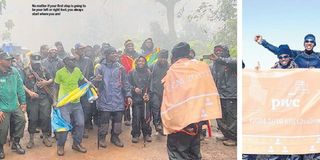Three key life lessons from my Kilimanjaro climb

In the game of basketball, there is a rule that “once you get a shot, you have to take it”. I took my shot when PwC Tanzania’s management communicated an opportunity to represent the firm on the Geita Gold Mine (GGM) 2019 Kili Challenge.
This Corporate Social Responsibility initiative to support the fight against HIV/Aids seeks not only to raise financial support, (in particular, for Tanzania Commission for Aids that implements intervention programs to fight HIV/Aids) but also to increase awareness, for example, challenges experienced by climbers can on some level give a sense of the myriad challenges an HIV positive person experiences.
At a personal level my motivation to climb Mount Kilimanjaro was triggered in June 2018, when I took pictures of Uhuru peak in a flight to Nairobi.
My encouragement has been a statement that, ‘you always start where you are.’ It was not easy to get to Uhuru peak but looking back to the climb journey, there are three key lessons I learned that are worth sharing: (i) mental strength tops physical strength, (ii) “follow the rules”, (iii) there are no shortcuts to success.
1. Lesson on mental strength
Mental strength kept me going when my physical strength was telling me to give up on the sixth day heading to the summit, on a 6.5 km steep hike battling a strong cold wind and blocks of ice.
We had reached Barafu Camp at about mid-day a day before and were leaving for summiting at 1am.
Theoretically, this meant some time to sleep. The reality though was that the high altitude and resultant bright sunlight, as well as my own body clock, prevented me from sleeping until midnight - only half an hour before we were woken up to get ready.
It was therefore no surprise that about three hours into the nearly eight-hour trip to the summit my body was telling at me to descend.
BUT….my mind was telling it was strong enough and I had enough oxygen to make it to Uhuru peak. Despite pins and needles, I decided to go with my mind, which insisted that as a runner I must have built endurance in me to face pain.
I also remembered the counsel of a fellow climber, Dr Jerome Kamwela from Tacaids, that once you feel exhausted to the maximum know that you have only utilised 40 per cent of your body potential. Apparently, this was the time for my body to unleash the remaining 60 per cent!
2. Lesson on playing by the rules
“Play by the rules” was one hard lesson from the mountain. As you advance in your climb, higher altitude means less oxygen, and the only natural way for your body to get used to increasing altitude is to advance at a very slow pace while doing calculated breaths with only your nose (and your mouth remaining shut all the time).
Altitude pills can also help. My lesson came on the third day of the climb; although I had breathed correctly (with only my nose), I made the mistake of not taking calculated breaths and so my rate of breathing was higher than it should have been as it did not match the pace of my legs.
As a result, altitude sickness insidiously hit me in the form of dizziness, headache, and loss of appetite reflecting the decline in oxygen as we reached Larva Tower (4600 metres above sea level).
As I descended to Baranco camp, vomiting treated the sickness. I had to start taking altitude pills and play by the rule of matching my breath to the pace of my legs that helped me advance for the rest of the days to Uhuru peak.
3. Lesson on shortcuts
There are no shortcuts to success. For example, routes designed by the mountain guides are deliberately in the form of a zigzag; and as an outsider, you might be tempted to shortcut the zigzag by going straight.
But disdain for the zigzag route may mean that you do not acclimatize properly and ultimately end up with inadequate oxygen to proceed with your climb.
Although I did not break this rule, I highlight it to reinforce the message that we have to work hard for our ultimate goals. As they say, “haraka haraka haina baraka!”
Embracing the message for 2019 GGM Kili Challenge, we were reminded of another shot to take by way of a check for HIV/Aids at a nearby health centre. From there, we can know if we have to keep ourselves safe or to follow subsequent health procedures.
All we need is mental strength, suitability to context and following instructions from health practitioners. No matter if your first step is going to be your left or right foot, you always start where you are!
Augustine Malija is an Associate - Assurance Services. The views expressed do not necessarily represent those of PwC. For PwC updates on Tax and other matters visit our website www.pwc.co.tz



